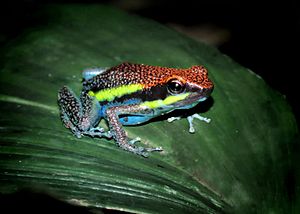Manú poison frog facts for kids
Quick facts for kids Manú poison frog |
|
|---|---|
 |
|
| Conservation status | |
| Scientific classification | |
| Synonyms | |
|
Epipedobates macero Rodríguez & Myers, 1993 |
The Manú poison frog (Ameerega macero) is a small, colorful frog. It belongs to a group of frogs known for their bright colors. These colors often warn predators that they are poisonous. This frog lives in the warm, wet forests of southern Peru and Brazil.
Contents
About the Manú Poison Frog
The Manú poison frog is part of the Dendrobatidae family. This family is also called the poison dart frog family. Many frogs in this group have toxins in their skin. These toxins can protect them from animals that might want to eat them. The Manú poison frog was first described in 1993.
Where They Live
You can find the Manú poison frog in several river areas. These include the Manú River, Urubamba River, Upper Purus River, and Ucayali River drainages. They also live in special protected areas. These areas are Serra do Divisor National Park and Alto Juruá Extractive Reserve. These places are important for keeping their homes safe.
Their Forest Home
Manú poison frogs prefer certain types of forests. They live in lowland tropical moist forests. These are warm, wet jungles found at lower elevations. They also live in montane forests. These are forests found higher up on mountains. Sometimes, they even live in bamboo forests. These frogs can be found at elevations from about 150 meters to 1,450 meters high. That's like living from sea level up to the top of a small mountain!
Why They Are Special
Like other poison frogs, the Manú poison frog has bright skin. This skin can be a warning sign. It tells other animals to stay away. This is a clever way for them to protect themselves. They are an important part of their forest ecosystem. They help control insect populations.
What Threatens Them
Sadly, the Manú poison frog faces some dangers. One big threat is habitat loss. Their forest homes are being cut down. This happens because of farming and other human activities. When their homes disappear, they have nowhere to live.
Illegal Pet Trade
Another problem for these frogs is the illegal pet trade. Some people try to catch them from the wild. They want to sell them as pets. This is against the law. Taking frogs from their natural homes can hurt their populations. It makes it harder for them to survive in the wild. Protecting their habitat and stopping illegal trade are important steps. These steps help keep the Manú poison frog safe for the future.
See also
 In Spanish: Ranita venenosa de Manu para niños
In Spanish: Ranita venenosa de Manu para niños
Images for kids




